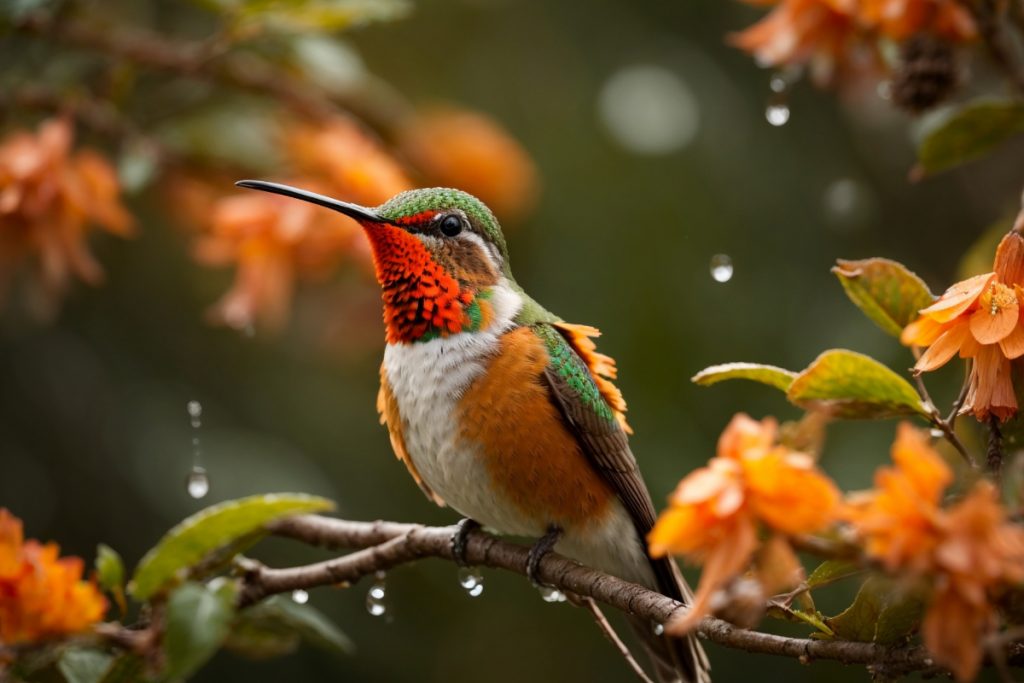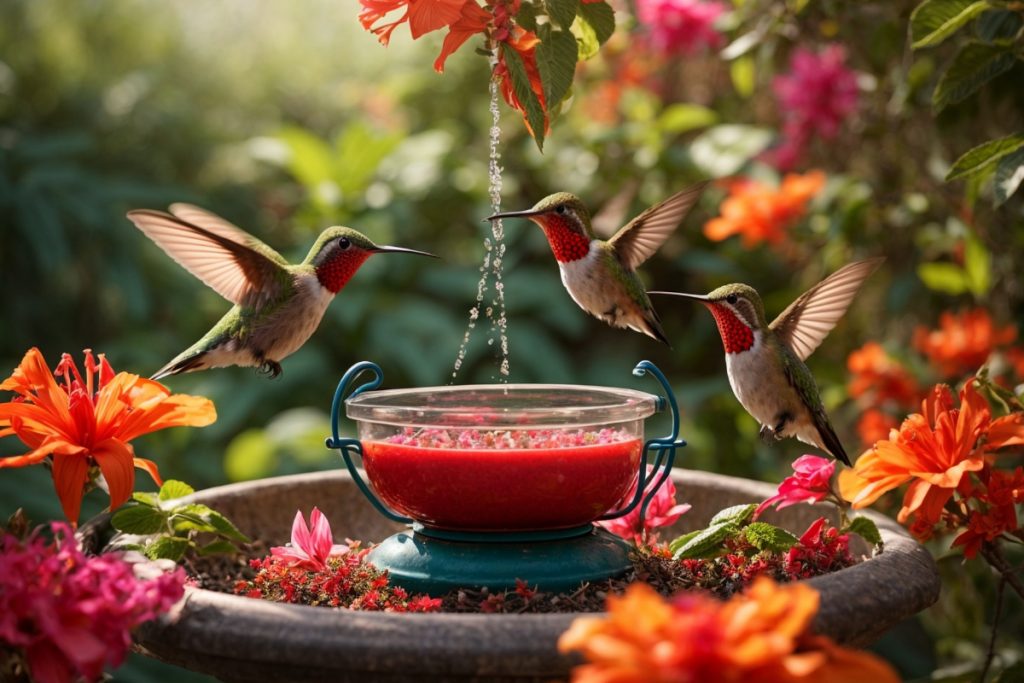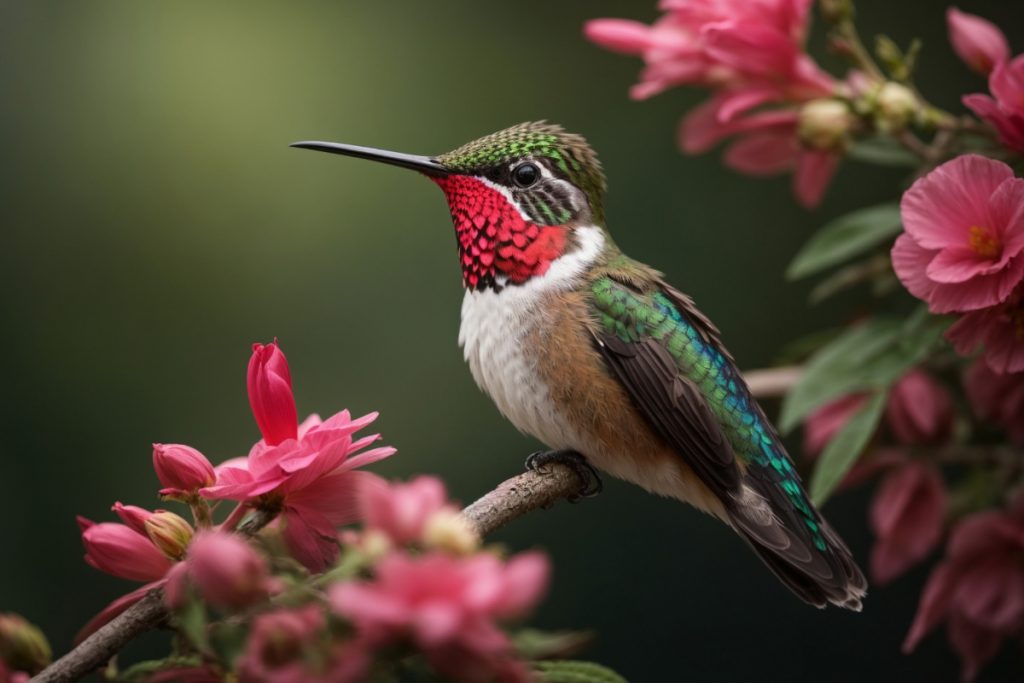With its temperate climate, lush landscapes, and abundance of flowers, Florida is a veritable haven for various bird species, including the mesmerising hummingbirds. These tiny, energetic birds have always been a subject of wonder and fascination for many. Their quick, darting movements and iridescent colours captivate both residents and tourists alike.
But one question that often arises is: When do these beautiful birds say farewell to Florida every year, and when do they return?
When Do Hummingbirds Leave Florida?
Hummingbirds in Florida begin their migration journey southwards from Florida in September, often heading to the warmer regions of Mexico and Central America. By the end of October, most, if not all, migrating hummingbirds will have departed from Florida.
In this blog post, we will delve into the habits, migration patterns, and the reasons behind why hummingbirds leave Florida every year before winter.
After reading this article, you will have a better understanding of their migration timeline, their behaviour and how you can play a part in their conservation.
Key Takeaways:
- Florida’s hummingbirds, including species like Ruby-throated, Black-chinned, and Rufous, start migrating to warmer regions around September, completing their departure by October’s end.
- Some Rufous hummingbirds choose to overwinter in Florida, bypassing the migration.
- Migration triggers encompass diminishing food sources, daylight changes, and slight temperature drops.
- Residents can support migrating hummingbirds by offering clean feeders, planting native nectar sources, and providing water.
- Climate changes might alter hummingbird behaviours, with most returning to Florida between late February and early March.
Related post to read about Best Hummingbird Feeders
- When Do Hummingbirds Leave Florida?
- Key Takeaways:
- Species and Habits
- Migration Triggers and Patterns
- Supporting Hummingbirds in Florida
- Changing Climate Conditions
- When Do Hummingbirds Return to Florida?
- Conclusion
- Frequently Asked Questions (FAQs)
- Q: When is the prime hummingbird season in Florida?
- Q: How do weather conditions influence hummingbird migration?
- Q: Which are the common hummingbird species found in Florida?
- Q: Can Rufous Hummingbirds be spotted in South Florida during winter?
- Q: When do most hummingbirds depart from Florida to their winter homes?
- Q: How do food sources affect the migratory patterns of hummingbirds?
- Q: Are artificial hummingbird feeders recommended for backyard bird watchers?
- Q: When is the best time for hummingbird sightings in North Carolina?
- Q: What's the role of South Carolina in the hummingbird migration maps?
- Q: How do female Ruby-throated Hummingbirds differ in migration from the males?
- Q: Do Calliope Hummingbirds frequent Florida?
- Q: How does the breeding range of hummingbirds affect their migration?
- Q: Can baby hummingbirds be seen during the late winter in Florida?
- Q: How does the diet of hummingbirds change with the lack of tubular flowers?
- Q: Are Buff-bellied hummingbirds common winter visitors in Florida?
- Q: Is there a difference between the arrival of hummingbirds in North Florida versus South Florida?
- Q: Are juvenile hummingbirds less efficient in migration than older ones?
- Q: How important are natural sources versus artificial feeders during migration?
- Q: Do territorial behaviours of hummingbirds change during migration?
- Q: Can a sweeter solution in feeders help attract more hummingbirds?
- Q: What should I know about the nesting behaviour of hummingbirds?

Species and Habits
Which Species Of Hummingbirds Are Commonly Found In Florida?
Florida hosts a range of hummingbird species. While the Ruby-throated Hummingbird is by far the most common, you might also spot the Black-chinned, Rufous, or even the rare Calliope Hummingbird during certain times of the year.
Let me give a little more insight into these 4 species of hummingbirds:
- Ruby-throated Hummingbird: Predominantly green and white, the males sport a striking ruby-red throat. They are mainly found in gardens and woodlands.
- Black-chinned Hummingbird: Identifiable by their black chin and a thin strip of iridescent purple beneath, they frequent open woodlands and scrub areas.
- Rufous Hummingbird: Recognised by their bright orange and iridescent red throat, these birds are known for their long migration routes.
- Calliope Hummingbird: The smallest breeding bird in North America, they have streaked magenta feathers around their throat and prefer montane meadows during migration. Their presence in Florida is a delightful rarity.
Do Any Hummingbird Species Remain In Florida Throughout The Winter?
Interestingly, It’s widely known that most hummingbirds migrate when winter approaches, but some individual species, particularly the Rufous hummingbird, have been spotted in Florida during the winter months. Basically, instead of undertaking the demanding migration journey, they choose to stay and enjoy Florida’s comparatively mild winter temperatures.
One thing you should keep in mind regarding the Rufous hummingbird staying behind in Florida during some winter seasons is that various factors, including food availability and habitat conditions, could influence their choice. This simply highlights the adaptability and resilience of these stunning birds.
How Do Departure Times Differ For Hummingbird Species Migrating In Florida?
The departure timing of hummingbird migrations in Florida varies depending on the species. Typically, Ruby-throated Hummingbirds begin their migration in late summer and peak in September.
Meanwhile, Rufous Hummingbirds have a more diverse pattern. Some of these beautiful orange-hued birds arrive in Florida during the winter to enjoy its warmth, while others head out to seek colder regions to the north.

Migration Triggers and Patterns
What Are The Main Factors That Trigger The Hummingbirds’ Departure From Florida?
Several factors influence this:
- Food Availability: As nectar flowers start to wither and insect populations diminish, hummingbirds prepare to move to regions where natural foods are more abundantly available.
- Daylight: The length of daylight can influence their internal biological clocks, signalling to them that it’s time to migrate.
- Temperature: While Florida remains relatively warm, a slight drop can be an indicator for these birds to move to even warmer regions.
To Which Destinations Do Hummingbirds Typically Migrate After Leaving Florida?
Upon departing Florida during the colder months, hummingbirds predominantly migrate to Central America. They embark on an inspiring journey across the Gulf of Mexico in a precise, relentless flight, showcasing their remarkable energy.
Rather than a particular fixed destination, food abundance and favourable climatic conditions often influence their chosen or preferred destination.
It’s truly fascinating how these petite birds can cover such vast distances with such determination.
How Long Does The Typical Migration Journey Last For Hummingbirds Departing From Florida?
Hummingbirds leaving Florida for their migration undertake a significant journey covering hundreds of miles. Some species display incredible endurance and can fly continuously for up to 18 hours without resting, showcasing their remarkable stamina.
This inspiring migration highlights the resilience and tenacity of these tiny, beautiful birds as they navigate vast landscapes in search of warmer climates or breeding grounds.

Supporting Hummingbirds in Florida
What Precautions Can Florida Residents Take To Support Hummingbirds During Their Migration Period?
Your backyard can be a sanctuary for these visiting birds. Here’s how you can help:
Feeders: Ensure they’re clean and filled with the right nectar mixture (4 parts water to 1 part white sugar). Avoid using any artificial colours.
Plant Native: Plants like firebush, red buckeye, and salvia are not only beautiful but also serve as natural nectar sources every year to hummingbirds.
Provide Water: A shallow water dish can help them rehydrate and bathe.
What Are The Primary Food Sources For Hummingbirds In Florida Before Their Migration?
Before their long journey, they primarily feed on:
- Nectar from flowers like salvia, trumpet vine, and bee balm.
- Insects: Despite the common belief, nectar isn’t their only diet. They also consume insects for protein.
- Tree Sap: Especially when flowers are not in bloom, tree sap becomes a substitute for nectar.

Changing Climate Conditions
How Are Changing Climate Conditions Affecting Hummingbird Migration Patterns In Florida?
Climate change is increasingly having an impact on many species, including hummingbirds. In Florida, the altering climate can affect the availability and timing of nectar sources, which hummingbirds rely on.
As temperatures rise and rainfall patterns shift, some traditional flowering seasons might alter, potentially leading to a mismatch between the hummingbirds’ arrival and the peak nectar availability.
Moreover, warmer winters could convince some hummingbirds to delay their departure or even spend the winter in Florida. While research is ongoing, there’s a growing consensus among ornithologists that changing climate conditions are influencing the migration and feeding habits of hummingbirds in the region, emphasising the need for adaptive conservation strategies to support these delicate birds.
When Do Hummingbirds Return to Florida?
Hummingbirds typically return to Florida in the spring, marking the beginning of a new breeding season. The exact timing can vary based on the species and environmental conditions, but for many, especially the commonly sighted Ruby-throated Hummingbird, the return journey commences around late February to early March.
The males usually precede the females by about a week to stake out and establish their territories. As March progresses, many hummingbirds can be observed zipping around the gardens, visiting flowers, and re-establishing their presence in the Florida landscape.
It’s important to note that these dates can vary slightly based on specific regional climate conditions, food availability, and other ecological factors.
So, for those keen on spotting them, keeping an eye out early in the spring and having feeders ready can provide an excellent opportunity to witness their return.
Conclusion
Hummingbirds have always captured our attention and admiration with their stunning colours and breathtaking aerial manoeuvres. However, comprehending their behaviour and migration patterns can help us move beyond mere admiration and participate in their preservation.
So, the next time you catch a glimpse of hummingbirds, take a moment to appreciate not just its beauty but also its resilience. Who knows, you might even be inspired to contribute in your own little way to ensure their safe passage through Florida.

Frequently Asked Questions (FAQs)
Q: When is the prime hummingbird season in Florida?
A: The prime hummingbird season in Florida starts with their spring migration return, typically around late February to early March, and lasts until their departure around the end of October.
Q: How do weather conditions influence hummingbird migration?
A: Weather conditions, especially temperature fluctuations, can serve as indicators for hummingbirds to migrate. Cooler weather can signal the need to move to warmer wintering grounds, typically in Central and South America.
Q: Which are the common hummingbird species found in Florida?
A: Common species in Florida include the Ruby-throated Hummingbird (Archilochus colubris), Black-chinned, Rufous, Calliope, and occasionally, the Broad-tailed and Broad-billed Hummingbirds.
Q: Can Rufous Hummingbirds be spotted in South Florida during winter?
A: Yes, some individual Rufous Hummingbirds choose to winter in Florida, enjoying the region’s milder climate.
Q: When do most hummingbirds depart from Florida to their winter homes?
A: Most hummingbirds begin their migration southwards in September, and by the end of October, most will have departed Florida for their winter homes in Central and South America.
Q: How do food sources affect the migratory patterns of hummingbirds?
A: The availability of food sources, especially wildflower nectar from native flowers and insects, plays a crucial role in determining the migration patterns of hummingbirds. A lack of food can trigger an earlier departure.
Q: Are artificial hummingbird feeders recommended for backyard bird watchers?
A: Yes, hummingbird feeders filled with the right nectar mixture can provide an accessible food source for these amazing birds. It’s essential to avoid using food colouring or sugar substitutes like honey.
Q: When is the best time for hummingbird sightings in North Carolina?
A: The best time for hummingbird sightings in North Carolina aligns with the spring and fall migrations. Late spring and early fall are peak times.
Q: What’s the role of South Carolina in the hummingbird migration maps?
A: South Carolina is a part of the migration route for many American hummingbird species, serving as a transitional point before they head further south.
Q: How do female Ruby-throated Hummingbirds differ in migration from the males?
A: Female Ruby-throated Hummingbirds typically follow the males during migration, arriving about a week later to allow males to establish their territories.
Q: Do Calliope Hummingbirds frequent Florida?
A: While the Calliope Hummingbird is rare in Florida, they can occasionally be spotted during certain times of the year.
Q: How does the breeding range of hummingbirds affect their migration?
A: The breeding range, which varies among species, determines their migration starting points. Regions like British Columbia are common breeding grounds for some species.
Q: Can baby hummingbirds be seen during the late winter in Florida?
A: Late winter is not the typical breeding season for hummingbirds in Florida. Baby hummingbirds are more commonly observed during the spring and summer.
Q: How does the diet of hummingbirds change with the lack of tubular flowers?
A: In the absence of tubular flowers, hummingbirds can turn to tree sap, insects for protein, and feeders with sugar solution.
Q: Are Buff-bellied hummingbirds common winter visitors in Florida?
A: While Buff-bellied hummingbirds do winter in parts of the United States, they are not the most common winter visitors in Florida. Rufous Hummingbirds are more frequently spotted.
Q: Is there a difference between the arrival of hummingbirds in North Florida versus South Florida?
A: Yes, the arrival of hummingbirds can vary based on the region. Typically, hummingbirds may reach South Florida slightly earlier than North Florida due to the warmer weather.
Q: Are juvenile hummingbirds less efficient in migration than older ones?
A: Juvenile hummingbirds, during their first migration, might not be as efficient as older hummingbirds, given their lack of experience. However, they instinctively know the direction and destination.
Q: How important are natural sources versus artificial feeders during migration?
A: While hummingbirds rely heavily on natural sources like wildflowers for nectar, artificial feeders can provide additional, abundant food supplies, especially in regions or times when natural sources are sparse.
Q: Do territorial behaviours of hummingbirds change during migration?
A: Territorial behaviour is more pronounced during breeding seasons. During migration, while hummingbirds can still be protective of abundant food sources, the urgency to migrate often overrides extreme territorial tendencies.
Q: Can a sweeter solution in feeders help attract more hummingbirds?
A: While hummingbirds are attracted to sweet solutions, it’s essential to stick to the 4:1 water-to-cane sugar ratio to maintain their health. Too sweet a solution can be harmful.
Q: What should I know about the nesting behaviour of hummingbirds?
A: Hummingbirds are meticulous when it comes to nesting. Female hummingbirds typically select a secure and sheltered location for their nests, often on a tree branch or sheltered ledge. The nests are intricately crafted with plant fibres and spider webs and are sometimes decorated with lichen. Inside, the female will lay 1 to 3 pea-sized eggs. During the incubation period, she’s responsible for keeping the eggs warm and will fiercely defend her nest. It’s crucial not to disturb a nesting hummingbird, ensuring her young have the best chance at survival.
Related Posts to Read: Hummingbirds Migrations
- Best Hummingbird Feeders.
- When Do Hummingbirds Leave Ohio?
- When Do Hummingbirds Leave Michigan?
- When Do Hummingbirds Leave Pennsylvania?
Related Posts to Read: Hummingbirds Availability by Locations.
- Are there Hummingbirds in Albuquerque?
- Are There Hummingbirds in Arizona?
- Are there Hummingbirds in Alberta?
- Are There Hummingbirds In Alabama?
- Are There Hummingbirds In Mexico?
- Are There Hummingbirds In The Caribbean?
- Are There Hummingbirds In Canada?
- Are There Hummingbirds In Jamaica?
- Are There Hummingbirds In Florida?
- Are There Hummingbirds In Massachusetts?
- Are There Hummingbirds In Michigan?
- Are There Hummingbirds In Texas?
- Are There Hummingbirds In New Jersey?
- Are There Hummingbirds In New York?
References:
- About Hummingbird (Wikipedia).
- About Florida (Link)
- Greenewalt, C. H. (1960). Hummingbirds. New York: Doubleday. Google Scholar.
- Carey C. The impacts of climate change on the annual cycles of birds. Philos Trans R Soc Lond B Biol Sci. 2009 Nov 27; 364(1534):3321-30. doi: 10.1098/rstb.2009.0182. PMID: 19833644; PMCID: PMC2781852.
